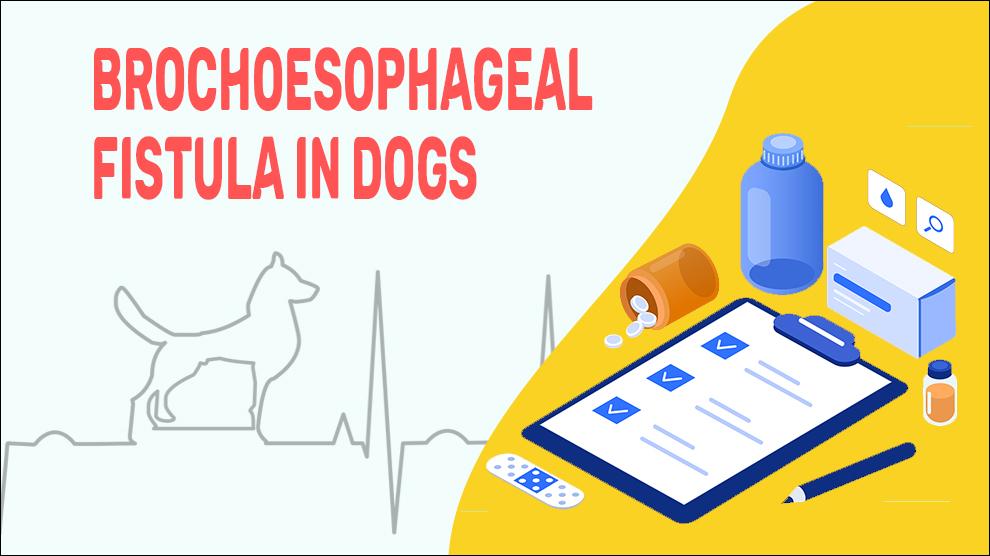What Is Brochoesophageal Fistula In Dogs?
A bronchoesophageal fistula (BEF) is a rare complication and most commonly develops secondarily due to endoscopic intervention or ingested foreign bodies in the esophagus. Fistulas may also develop due to locally advanced bronchogenic or esophageal malignancy.
The incidences of the tracheoesophageal fistula are more common than the Congenital BE fistula. Acquired causes of BE fistula include infections, traumatic factors (like blunt chest injury, prolonged endotracheal intubation), and malignancies.
Dogs with benign BEF often have a relatively subtle clinical course. The combination of the rarity of benign BEF and nonspecific symptoms often results in longer neglect without diagnosis and proper treatment.
What Are The Symptoms Of Brochoesophageal Fistula In Dogs?
- Paroxysmal cough while eating or drinking (Ohno's sign)
- Dysphagia
- Fever
- Recurrent pulmonary infections
- Hemoptysis
- The fullness of stomach with air after expiration
- Basal crackles
- Pleural effusion
Treatment Options For Brochoesophageal Fistula In Dogs
Treatment is not required for dogs that are asymptomatic and those that have a good quality of life.
Medical management for Dogs with mild symptoms may be necessary to support lung function and reduce congestive heart failure.
Severe BEF requires surgical correction. Affected dogs should be clinically evaluated thoroughly for any other potentially associated congenital defects.
The minimally invasive approach for the treatment of broncho-esophageal fistula is Video-assisted thoracoscopic surgery.
Prognosis varies by case, stage of disease, and overall health of the dog.
Home Remedies For Brochoesophageal Fistula In Dogs
- Talk to Your Veterinarians and understand your pet's treatment options.
- Pain can be so subtle in dogs - access your dog's pain and watch out for any abnormal behavior.
- Don't forget even sick dogs need a few low-stress activities and a lot of rest.
- Get a good pet sitter. For those who could not spend enough time at the home, make sure you have a reliable pet sitter.
- Work with your vet to find the optimal dietary plan for your dog.
- Home remedies such as herbs, diet, and exercise will depend on your dog's age and stage of the disease they are in.
How To Prevent Brochoesophageal Fistula In Dogs?
Prevention of congenital BEF is a hereditary concern. Dogs with BEF including First degree relatives (littermates and parents) should not be bred so as to avoid passing the condition on to the next generation.
Screening of highly affected breeds prior to breeding is strongly recommended.
Dog Breeds Affected By Brochoesophageal Fistula In Dogs
There is no breed, sex or age predisposition. Cairn Terrier
Types Of Brochoesophageal Fistula In Dogs
- Bronchoesophageal fistulas (BEF's) may be congenital or acquired.
- Congenital BEF's always manifest clinically in early infancy.
- Congenital BEFs are classified into four types:
- Simple BEF.
- Congenital BEF (associated with oesophageal diverticulum).
- BEF with intralobar cyst.
- BEF communicating with pulmonary sequestration.
- Simple BEF's may remain dormant until adulthood if the fistula is between the respiratory tract and esophagus.
When To See A Vet For Brochoesophageal Fistula In Dogs?
The typical approach for this condition is no treatment is needed until symptoms are noted.
Treatment for BEF varies according to the presence of other heart abnormalities and the extent of the defects.
For young, otherwise healthy dogs with a life-threatening defect, surgery may be effective but this will depend on the recommendation of a veterinarian.
Diet And Food Suggestions For Brochoesophageal Fistula In Dogs
Points to remember:
- Spicy foods, Greasy, fried foods and Allergens (gluten, soy, and dairy).
- Eliminate colorings, preservatives, additives, and flavors from your pet's diet.
- Include dog-safe spices like turmeric, ginger, cumin, and coriander.
- Don't switch up food a lot but an occasional mix and match of foods are ok.
- Reduce the carb and increase good fatty foods for your dog.
- Generally, all ingredients should be fresh, easily digested, highly palatable with a good smell, and should be highly bioavailable.
What to feed?
- Whole, unprocessed foods.
- Fresh food.
- Low-carb dog food.
- Probiotics and digestive enzymes.
- Fresh, lean protein.
- Add oregano or basil to their diet.
- Animal Essentials Detox Blend: (combination of herbs suspended in glycerine).
- This will help your dog detox.
- The raw diet, Semi-Homemade Food (commercial homemade diet with a dehydrated formula), or home-cooked meals.
Lung Cleansing and balancing diet.
Feed according to weight (twice a day for 21 days).
- Protein: 40% of diet - use one at a time.
Turkey sandwich or chicken salad.
Chicken breast, steak, or burgers.
Raw beef + beef liver (75% beef, 25% liver).
Eggs or yogurt or cottage cheese.
- Grains: 1/3rd or 30% of the diet.
Oats or brown rice or buckwheat.
- Leafy greens and vegetables: 30% of the diet.
Spinach, kale, broccoli, carrots, beets, cucumber, celery, green or yellow beans, radishes, etc.,
(Put through a food processor or lightly steam).
- Herbs: 2 tsp dried (any one or two).
Fennel, burdock, aloe vera, ginseng, strawberry leaves, fenugreek, angelica, lobelia, etc.,
- Fruits: 1 Tbsp - blueberries, blackberries, apples, papayas, pumpkins.
Conclusion
The prognosis for BEF in dogs depends on its size, location, and how early it was treated. The survival rate for dogs that undergo surgical repair for congenital BEF is good.
So far, there is no single recurrence of BEF after surgical procedures. Many BEF dogs can live normal lives if they are without any other complications. Dogs with mild symptoms can be managed with medications.

















